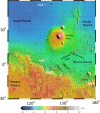Geology of the InSight landing site on Mars
- PMID: 32094337
- PMCID: PMC7039939
- DOI: 10.1038/s41467-020-14679-1
Geology of the InSight landing site on Mars
Abstract
The Interior Exploration using Seismic Investigations, Geodesy and Heat Transport (InSight) spacecraft landed successfully on Mars and imaged the surface to characterize the surficial geology. Here we report on the geology and subsurface structure of the landing site to aid in situ geophysical investigations. InSight landed in a degraded impact crater in Elysium Planitia on a smooth sandy, granule- and pebble-rich surface with few rocks. Superposed impact craters are common and eolian bedforms are sparse. During landing, pulsed retrorockets modified the surface to reveal a near surface stratigraphy of surficial dust, over thin unconsolidated sand, underlain by a variable thickness duricrust, with poorly sorted, unconsolidated sand with rocks beneath. Impact, eolian, and mass wasting processes have dominantly modified the surface. Surface observations are consistent with expectations made from remote sensing data prior to landing indicating a surface composed of an impact-fragmented regolith overlying basaltic lava flows.
Conflict of interest statement
The authors declare no competing interests.
Figures










References
-
- Banerdt, W. B. et al. Early results from the InSight mission: surface environment and global seismic activity. Nat. Geosci. 10.1038/s41561-020-0544-y (2020).
-
- Golombek M, et al. Selection of the InSight landing site. Space Sci. Rev. 2017;211:5–95.
-
- Golombek M, et al. Geology and physical properties investigations by the InSight Lander. Space Sci. Rev. 2018;214:84.
-
- Tanaka, K. L., et al. Geologic Map of Mars, 1:20,000,000, USGS Scientific Investigations Map 3292 (2014).
-
- Smrekar SE, et al. Pre-mission InSights on the interior of Mars. Space Sci. Rev. 2018;215:3.
Publication types
LinkOut - more resources
Full Text Sources
Miscellaneous

